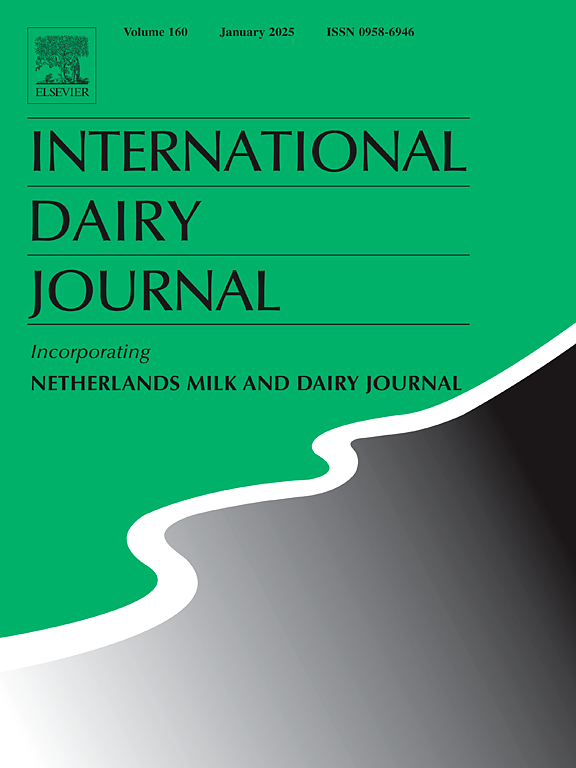Effect of phenolic compounds on proteolytic activity and spoilage potential of Pseudomonas aeruginosa in milk
IF 3.4
3区 农林科学
Q2 FOOD SCIENCE & TECHNOLOGY
引用次数: 0
Abstract
Psychrotrophic bacteria, notably Pseudomonas spp., are common contaminants in raw milk and food industry. This study evaluated the effects of four phenolic compounds (rosmarinic acid, baicalein, curcumin, and resveratrol) on the proteolytic activity of Pseudomonas aeruginosa PAO1 in UHT skimmed milk (UHT-SM) at concentrations from 12.5 to 500 μM, depending on the compound. In vitro and in situ assays were conducted to assess proteolysis, spoilage, and milk protein hydrolysis. Significant inhibition of proteolytic activity was observed in vitro, whereas in UHT-SM the effect was partial. Curcumin and resveratrol reduced proteolysis in solid medium, while baicalein, curcumin, and resveratrol decreased spoilage intensity at higher concentrations. SDS-PAGE confirmed milk protein hydrolysis, especially of caseins, in all treatments, and confirmed delayed proteolysis in the presence of phenolics. These findings suggest that interactions between phenolic compounds and milk components may limit their antimicrobial potential, highlighting the need for further studies to better understand these interactions and enhance their applicability.
酚类化合物对牛奶中铜绿假单胞菌蛋白水解活性和腐败潜力的影响
嗜冷细菌,尤其是假单胞菌,是原料奶和食品工业中常见的污染物。本研究评估了四种酚类化合物(迷香酸、黄芩素、姜黄素和白藜芦醇)在12.5 ~ 500 μM的UHT脱脂牛奶(UHT- sm)中对铜绿假单胞菌PAO1蛋白水解活性的影响。进行了体外和原位分析,以评估蛋白质水解,腐败和牛奶蛋白水解。体外观察到明显的蛋白水解活性抑制,而在UHT-SM中,效果是部分的。姜黄素和白藜芦醇在固体培养基中降低蛋白质水解,而黄芩素、姜黄素和白藜芦醇在较高浓度下降低腐败强度。SDS-PAGE证实牛奶蛋白水解,尤其是酪蛋白,在所有处理中,并证实在酚类物质存在下延迟蛋白水解。这些发现表明,酚类化合物与牛奶成分之间的相互作用可能会限制其抗菌潜力,强调需要进一步研究以更好地了解这些相互作用并增强其适用性。
本文章由计算机程序翻译,如有差异,请以英文原文为准。
求助全文
约1分钟内获得全文
求助全文
来源期刊

International Dairy Journal
工程技术-食品科技
CiteScore
6.50
自引率
9.70%
发文量
200
审稿时长
49 days
期刊介绍:
The International Dairy Journal publishes significant advancements in dairy science and technology in the form of research articles and critical reviews that are of relevance to the broader international dairy community. Within this scope, research on the science and technology of milk and dairy products and the nutritional and health aspects of dairy foods are included; the journal pays particular attention to applied research and its interface with the dairy industry.
The journal''s coverage includes the following, where directly applicable to dairy science and technology:
• Chemistry and physico-chemical properties of milk constituents
• Microbiology, food safety, enzymology, biotechnology
• Processing and engineering
• Emulsion science, food structure, and texture
• Raw material quality and effect on relevant products
• Flavour and off-flavour development
• Technological functionality and applications of dairy ingredients
• Sensory and consumer sciences
• Nutrition and substantiation of human health implications of milk components or dairy products
International Dairy Journal does not publish papers related to milk production, animal health and other aspects of on-farm milk production unless there is a clear relationship to dairy technology, human health or final product quality.
 求助内容:
求助内容: 应助结果提醒方式:
应助结果提醒方式:


